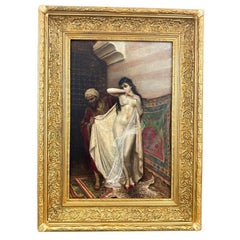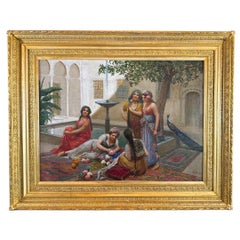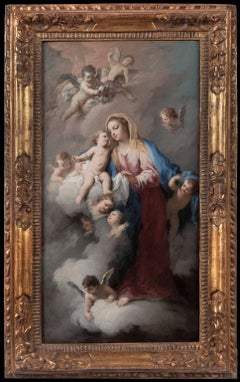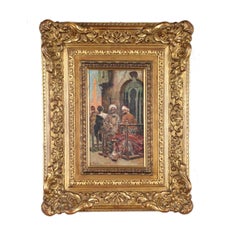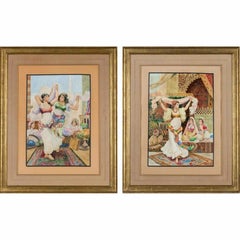Fabio Fabbi Art
Italian, 1861-1910
“Fabio Fabbi studied painting and sculpture at the Accademia di Belle Arti in Florence, in the studio of Augusto Rivalta, and won several prizes in both disciplines during the early 1880s. He then visited Paris, Munich and Egypt. When he returned to Italy he devoted himself solely to painting. In 1893, he was teaching at the Accademia in Florence, and in 1894 he was a member of the Accademia di Belle Arti in Bologna. He was decorated with the title of knight of the crown of Italy in 1898.
Fabio Fabbi painted a few religious pictures, but he mostly chose Middle Eastern themes for his subjects: odalisques, markets, bazaars and harems. He also designed medals. The style of his paintings varies according to the technique used. In his pastel works, form and movement are merely suggested by a few strokes of the chalk, whereas his oil paintings on ivory are more boldly executed. He chose the medium of watercolor to illustrate new editions of the Aeneid, the Iliad and the Odyssey.
He took part in various exhibitions including exhibitions in Monaco, in Turin from 1884 where he won a prize in 1899, in Florence in 1888, and in Milan” (Benezit, Dictionary of Artists, Gründ, 2006).to
1
1
Overall Width
to
Overall Height
to
2
1
1
2
2
2
1
2
2
2
2
2
10,065
2,764
1,381
1,375
1
2
Artist: Fabio Fabbi
A Fair Price
By Fabio Fabbi
Located in Jacksonville, FL
Fabio Fabbi, born in Italy in 1861, stands as an acclaimed Orientalist painter renowned for his devotion to capturing the exotic allure of the Orie...
Category
19th Century Fabio Fabbi Art
Materials
Canvas, Oil
$49,000
Harem Girls in the Palace Courtyard 19th Century Antique Oil Painting on Canvas
By Fabio Fabbi
Located in Jacksonville, FL
Description:
Fabio Fabbi: A Master of Orientalist Intrigue
The painting is signed on the bottom left side.
Fabio Fabbi, an esteemed Italian artist of the late 19th and early 20th centuries, emerged as a prominent figure within the Orientalist art movement. Born in Rome in 1861, Fabbi’s passion for capturing the exotic and mysterious landscapes and cultures of the East would define his artistic career and leave an indelible mark on the art world.
Fabbi’s artistic journey began with formal training at the Accademia di Belle Arti in Rome, where he developed a deep appreciation for classical techniques and aesthetics. However, it was his encounters with Orientalist themes and subjects that ignited his imagination and set him on a path to becoming a renowned master of Orientalist art.
One of Fabbi’s most captivating works, “Harem Girls in the Palace Courtyard,” stands as a testament to his exceptional talent for depicting scenes of intrigue and sensuality within the luxurious settings of the Ottoman Empire. This mesmerizing painting invites viewers into the opulent world of a harem, where a group of beautiful women gracefully gather in a sunlit courtyard. Fabbi’s brushwork skillfully captures the vibrant colors, exquisite textiles, and intricate architectural details that define the environment.
In “Harem Girls in the Palace Courtyard,” Fabbi delves into the alluring realm of the harem, exploring the interplay between power, desire, and secrecy. With meticulous attention to detail, he captures the expressions and body language of the women, evoking a sense of mystery and sensuality. The play of light and shadow adds depth and dimension to the composition, further immersing viewers in the rich atmosphere of the scene.
Fabbi’s ability to weave narratives within his artworks sets him apart. “Harem Girls in the Palace Courtyard” not only showcases his technical skill but also tells a story—a glimpse into a hidden world that fascinates and captivates. Through his artistry, Fabbi offers a nuanced portrayal of Eastern culture, emphasizing the beauty and complexity that lie beneath the surface.
Throughout his career, Fabio Fabbi gained recognition and admiration for his Orientalist works. His paintings were exhibited in prominent galleries across Europe, where audiences marveled at his ability to transport them to distant lands and evoke a sense of wonder and intrigue. Fabbi’s talent for capturing the essence of Orientalist themes and his exquisite attention to detail earned him a place among the most respected artists of his time.
Fabio Fabbi’s legacy lives on through his remarkable artworks. His ability to portray the mysteries and allure of the East continues to inspire and captivate art enthusiasts worldwide. “Harem Girls in the Palace Courtyard” exemplifies Fabbi’s mastery of the Orientalist genre, inviting viewers to step into a world of beauty, enchantment, and hidden desires.
His paintings exhibited at prestigious venues in Turin and Milan. Knighted in the Order of the Crown of Italy in 1892. Notable works include the Sacred Heart...
Category
19th Century Realist Fabio Fabbi Art
Materials
Canvas, Oil
Related Items
Italian 18th Century Oval Religious Oil on Canvas Painting with Saint Dominic
By Francesco de Mura
Located in Firenze, IT
This beautiful Italian 18th Century old masters oil painting on oval canvas with giltwood frame is attributed to Solimena and features a religious scene.
In this splendid oval-shaped painting are depicted Saint Dominic...
Category
18th Century Old Masters Fabio Fabbi Art
Materials
Canvas, Oil
$13,141
H 21.66 in Dm 15.75 in
Madonna and Child with Angels in the Clouds
Located in New York, NY
Provenance: Charles H. and Virginia Baldwin, Claremont, Colorado Springs, Colorado ca. 1907-1934; thence by descent until sold in 1949 to:
Charles Blevins Davis, Claremont (renamed Trianon), Colorado Springs 1949 -until gifted in 1952 to:
The Poor Sisters of Saint Francis, Trianon, Colorado Springs, 1952 until acquired, 1960, by:
John W. Metzger, Trianon, renamed as the Trianon School of Fine Arts, Colorado Springs, 1960-1967; when transferred to:
The Metzger Family Foundation, Trianon Art Museum, Denver, 1967 - 2004; thence by descent in the Metzger Family until 2015
Exhibited: Trianon Art Museum, Denver (until 2004)
The present work is a spectacular jewel-like canvas by Amigoni, rich in delicate pastel colors, most likely a modello for an altarpiece either lost or never painted. In it the Madonna stands firmly upon a cloud in the heavens, her Child resting on a delicate veil further supported by a cloud, as he gently wraps his arm around his mother’s neck. From above angels prepare to lower flowers and a wreath, while other angels and seraphim surrounding the two joyfully cavort.
Dr. Annalisa Scarpa, author of the forthcoming monograph on Jacopo Amigoni...
Category
18th Century and Earlier Fabio Fabbi Art
Materials
Canvas, Oil
Old Times House Interior Scene with Naughty Boy 19th century Genre Oil Painting
Located in Stockholm, SE
The painting captures a wonderfully amusing family moment set in the 16th century. In the center of the painting we see the father, exhausted by worries and dozing in his chair in fr...
Category
Late 19th Century Realist Fabio Fabbi Art
Materials
Canvas, Wood, Oil
$350
H 24 in W 19.7 in D 1 in
English Mid century oil of a cafe or Pub interior, people seated and drinking
Located in Woodbury, CT
M. Ricket (British, mid-20th century)
Café Interior
Oil on canvas, signed lower right
Presented in a carved gilt frame
This engaging mid-century scene by M. Ricket captures the war...
Category
1930s Realist Fabio Fabbi Art
Materials
Canvas, Oil
"The Barber of Seville", Early 20th Century Oil on Canvas by José Villegas
Located in Madrid, ES
JOSÉ VILLEGAS CORDERO
Spanish, 1844 - 1921
THE BARBER OF SEVILLE
signed & dated "J. Villegas. / Junio 1913." (lower left)
oil on canvas
19-3/8 x 28-3/4 inches (49 x 73 cm.)
framed: 27-1/2 x 36-3/4 inches (69.5 x 93 cm.)
PROVENANCE
Private Collector, Seville, Spain
José Villegas Cordero (Seville, August 26, 1844-Madrid, November 9, 1921) was a Spanish painter. He directed the Prado Museum between 1901 and 1918.
He was the brother of the painter Ricardo Villegas Cordero. He began his apprenticeship very young with José María Romero, with whom he remained for two years until entering the School of Fine Arts in Seville, where he was under the tutelage of Eduardo Cano.
In 1860, when he was only 16 years old, he sold his work Little Philosophy for 2,000 reais at the Seville Exhibition. In 1867 he traveled to Madrid, where he entered Federico Madrazo's studio. There he established friendship with painters Eduardo Rosales and Fortuny.
He went regularly to the Prado where he copied Velázquez, from whom he acquired spontaneity and the use of color for his technique.
Finally, and out of admiration for Fortuny's orientalist painting, he returned to Seville and organized an excursion to Morocco.
At the end of 1868 he decided to travel to Rome accompanied by the painters Rafael Peralta and Luis Jiménez Aranda...
Category
1910s Realist Fabio Fabbi Art
Materials
Canvas, Oil
$9,557
H 19.3 in W 28.75 in
Roberto Bompiani "The Confirmation" Museum Quality Large Scale Oil Painting
Located in San Francisco, CA
Roberto Bompiani (Italy, 1821-1908) "The Confirmation" Museum Quality Oil Painting circa 1871
Extraordinary oil painting by listed Italian artist.
T...
Category
Mid-19th Century Realist Fabio Fabbi Art
Materials
Canvas, Oil
$8,100
H 66 in W 94 in D 4 in
"The Florence Sisters", 19th Century Oil on Canvas, Spanish Artist José Villegas
Located in Madrid, ES
JOSÉ VILLEGAS Y CORDERO
Spanish 1844 - 1921
"The Florence Sisters"
signed "Villegas" (lower left)
oil on canvas
33-1/2 X 40-1/2 inches (84.5 X 102.5 cm.)
PROVENANCE
Private Collector, Seville, Spain
José Villegas Cordero (Seville, August 26, 1844-Madrid, November 9, 1921) was a Spanish painter. He directed the Prado Museum between 1901 and 1918.
Biography
He was the brother of the painter Ricardo Villegas Cordero. He began his apprenticeship very young with José María Romero, with whom he remained for two years until entering the School of Fine Arts in Seville, where he was under the tutelage of Eduardo Cano.
In 1860, when he was only 16 years old, he sold his work Little Philosophy for 2,000 reais at the Seville Exhibition. In 1867 he traveled to Madrid, where he entered Federico Madrazo's studio. There he established friendship with painters Eduardo Rosales and Fortuny.
He went regularly to the Prado where he copied Velázquez, from whom he acquired spontaneity and the use of color for his technique.
Finally, and out of admiration for Fortuny's orientalist painting, he returned to Seville and organized an excursion to Morocco.
At the end of 1868 he decided to travel to Rome accompanied by the painters Rafael Peralta and Luis Jiménez Aranda...
Category
Late 19th Century Realist Fabio Fabbi Art
Materials
Canvas, Oil
$10,752
H 33.27 in W 40.36 in
"Ballet Lessons", 20th Century Oil on Canvas by Sebastián Llobet Ribas, Spanish
Located in Madrid, ES
SEBASTIÁN LLOBET RIBAS
Spanish, 1887 - 1975
signed "Llobet Ribas" (lower right)
signed again "Llobet Ribas" (on the reverse)
oil on canvas
32 x 25-3/4 inches (80.5 x 65 cm.)
unframed
PROVENANCE
Private Collector, Barcelona
Painter and draftsman of the twentieth century, born in Barcelona in 1887. He attended the Fine Arts Schools and was a disciple of Vicente Climent. He participated in the Self-Portraits Exhibition held in 1907, in the Drawing Exhibition in the Sala Parés in 1910, in several of the Spring and International Exhibition, and in the National Exhibition of 1942 and 1944 in Barcelona and in 1950 in Madrid. In the 1951 Exhibition of the Circulo de Bellas Artes de Palma de Mallorca, he obtained a medal for the set of drawings...
Category
1930s Realist Fabio Fabbi Art
Materials
Canvas, Oil
"A Toast" Louis Charles Moeller, American 19th Century Realist Genre Painting
Located in New York, NY
Louis Charles Moeller
A Toast
Signed lower right
Oil on canvas
12 x 16 inches
Louis Charles Moeller was a master of American genre painting. His meticulously detailed, highly finish...
Category
19th Century Realist Fabio Fabbi Art
Materials
Canvas, Oil
Vincenzo Colleoni (Venetian Master) - 19th century painting - Interior Masks
Located in Varmo, IT
Vincenzo Colleoni (Active in Venice in the second half of the 19th century) - Interior scene with masked characters.
110 x 160 cm without frame, 145 x 194 cm with frame.
Antique oi...
Category
Late 19th Century Realist Fabio Fabbi Art
Materials
Canvas, Oil
$14,336 Sale Price
20% Off
H 57.09 in W 76.38 in
"Reales Alcázares de Sevilla" Large 20th Century oil on canvas by Liger Hidalgo
By Fernando Liger Hidalgo
Located in Madrid, ES
FERNANDO LIGER HIDALGO
Spanish , 1880 – 1945
"INTERIOR REALES ALCAZARES, SEVILLA"
Signed & located "F. Liger Hidalgo, Sevilla " (lower right)
...
Category
1920s Realist Fabio Fabbi Art
Materials
Canvas, Oil
The Wool Winder (1877) by Swedish Female Artist Emma Ekwall
Located in Stockholm, SE
In The Wool Winder, Emma Ekwall captures a moment of quiet domestic intimacy between a young woman and a man as they wind wool together—she with focused care, he with gentle attentiv...
Category
1870s Realist Fabio Fabbi Art
Materials
Canvas, Oil
$5,376
H 28.35 in W 24.81 in
Previously Available Items
Arabic coffee, late XIXth century
By Fabio Fabbi
Located in Milan, IT
Oil on the table. signed lower left. An orientalist subject who proposes the Arab coffee as a place also responsible for smoking the hookah, an activity in which two men are intent: ...
Category
Late 19th Century Other Art Style Fabio Fabbi Art
Materials
Oil
Fabio Fabbi ‘Italian, 1861-1946’ Pair of Orientalist Watercolors "Harem Dancers"
By Fabio Fabbi
Located in Queens, NY
Fabio Fabbi (Italian, 1861-1946)
An exceptional pair of Orientalist Watercolors "Harem Dancers"
Each signed F. Fabbi, lower right.
Each watercolor on paper
Sight Size o...
Category
19th Century Fabio Fabbi Art
Materials
Paper, Watercolor
Market Dancer
By Fabio Fabbi
Located in Los Angeles, CA
Wonderful Orientalist painting
Category
Early 1900s Fabio Fabbi Art
Materials
Oil, Canvas
Fabio Fabbi art for sale on 1stDibs.
Find a wide variety of authentic Fabio Fabbi art available for sale on 1stDibs. You can also browse by medium to find art by Fabio Fabbi in oil paint, paint, canvas and more. Not every interior allows for large Fabio Fabbi art, so small editions measuring 16 inches across are available. Customers who are interested in this artist might also find the work of Addison Thomas Millar, Dommersen, William Raymond, and John Horace Hooper. Fabio Fabbi art prices can differ depending upon medium, time period and other attributes. On 1stDibs, the price for these items starts at $28,000 and tops out at $75,000, while the average work can sell for $49,000.
